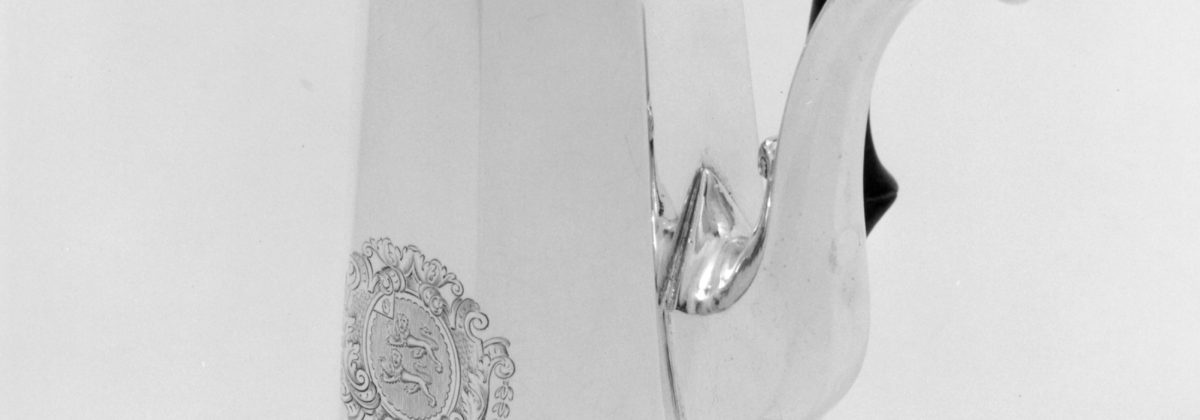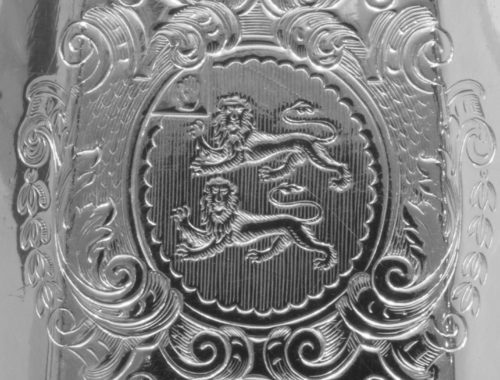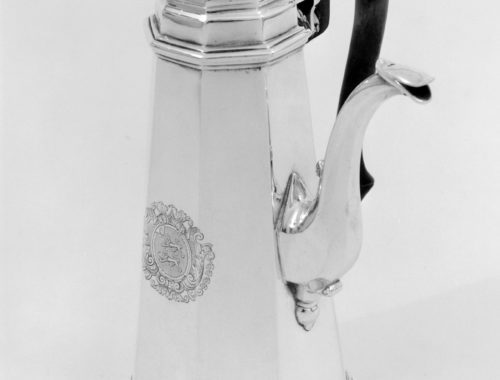Object number: #123
London, 1713/14
Robert Timbrell and Joseph Bell
City Hallmark: Figure of Britannia (Jackson 1921: 84)
Maker’s mark: Initials for the common mark of Robert Timbrell und Joseph Bell
(Grimwade 1990, no. 2707)
Assay mark: lion’s head erased (Jackson 1921: 84)
Date letter for 1713/4 (Jackson 1921: 84)
Engraving: contemporary crest
Height: 26,5 cm (10,43 in.); weight: 850 gr. (30 oz.)
Detailed Information
Antique Silver George I Octagonal Coffeepot
The present coffeepot has a slender form with eight edges and a smooth surface, which is adorned by an engraved crest framed in a laboriously decorated cartouche. The spout has an S-form, ends up in a bird’s head and is standing at a right angle to the handle. On the spot where the spout connects to the body, there is a beautiful elaborated decorative element. A cast baluster knob adorns the octagonal, high, vaulted hinged-lid. A very fine, geometric coffeepot of timeless elegance.
The form of the first coffeepots in England was strongly influenced by the Orient. Early English coffeepots had thus a conical lid with a pointed end. During the eighteenth century the lid had gained in curvature. The style developments of the period during 1710-20 gave the coffeepots an octagonal, very elegant, form. One can see the development of this style on the example of the present coffeepot. Moreover, the amount of silver corresponds to the Britannia Standard (i.d. a 95,84 % silver proportion), providing the coffeepot with an exceptional quality and colour.
European travellers knew coffee and tea since the sixteenth century. These warm beverages conquered the continent in the seventeenth century. They were at first sold in pharmacies as remedies and were consumed as healing beverages. Since the end of the seventeenth century though, coffee was increasingly consumed for pleasure and for its effect on the alertness and attention of the body and the intellect.
Makers
Robert Timbrell was son of Thomas Timbrell and has apprenticed by Augustine Dudley from 1678 to 1685 or 1686. Since 1707, he worked in partnership with Joseph Bell I. Joseph Bell was son of John Bell and apprenticed by Robert Timbrell from 1700 to 1707.
Literature
Grimwade, Ar., London Goldsmiths 1697-1837. Their marks and lives from the original registers at Goldsmiths’ Hall and other sources, GB: Faber and Faber, 1990 [Grimwade3].
Hernmarck, Carl, Die Kunst der europäischen Gold- und Silberschmiede von 1450 bis 1830, C.H. Beck Verlag: München, 1978.
Jackson, Ch., J., English Goldsmiths and their marks, London: MacMillan and Co. Limited, 1921.




